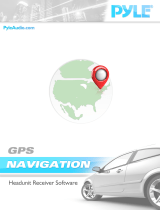
4
3.1.5 Selecting the destination from your Address Book ............................................ 46
3.1.6 Selecting a recent destination from the History ................................................. 47
3.1.7 Entering the coordinate of the destination ......................................................... 48
3.1.9 Building a route from the list of destinations (Create Route) ............................ 49
3.2 Viewing the entire route on the map ............................................................. 50
3.3 Checking route parameters and accessing route related functions .............. 50
3.4 Modifying the route ....................................................................................... 51
3.4.1 Selecting a new destination when already having a route: New Route, Waypoint or Final
Destination .................................................................................................................... 52
3.4.2 Setting a new starting position for the route ...................................................... 52
3.4.3 Editing the list of destinations (Edit Route) ....................................................... 53
3.4.4 Cancelling the active route................................................................................. 54
3.4.5 Checking route alternatives................................................................................ 54
3.4.6 Changing the vehicle used in route planning ..................................................... 55
3.4.7 Changing the road types used in route planning ................................................ 56
3.5 Saving a location as an Address Book entry ................................................. 58
3.6 Saving a location as an alert point ............................................................... 59
3.7 Editing an alert point .................................................................................... 60
3.8 Watching the simulation of the route ............................................................ 61
4 Off-road navigation ................................................................................ 63
4.1 Selecting the destination of the route ............................................................ 63
4.2 Navigating in off-road mode ......................................................................... 63
5 Reference Guide ..................................................................................... 64
5.1 Concepts ........................................................................................................ 64
5.1.1 Smart Zoom ....................................................................................................... 64
5.1.2 Route calculation and recalculation ................................................................... 64
5.1.3 Green routing ..................................................................................................... 66
5.1.4 Speed limit warning ........................................................................................... 66
5.1.5 Traffic information in route planning ................................................................ 67
5.1.5.1 Historical traffic ...................................................................................................... 67
5.1.5.2 Real-time traffic information (TMC) ........................................................................ 67
5.2 Information menu .......................................................................................... 68
5.3 Settings menu ................................................................................................ 70
5.3.1 Sound and Warnings .......................................................................................... 72
5.3.2 Customise Quick menu ...................................................................................... 74
5.3.3 Traffic settings ................................................................................................... 74
5.3.4 Route settings ..................................................................................................... 74
5.3.5 Map settings ....................................................................................................... 77
5.3.6 Visual guidance settings .................................................................................... 79
5.3.7 Regional settings ................................................................................................ 80
5.3.8 Trip monitor settings .......................................................................................... 81
























